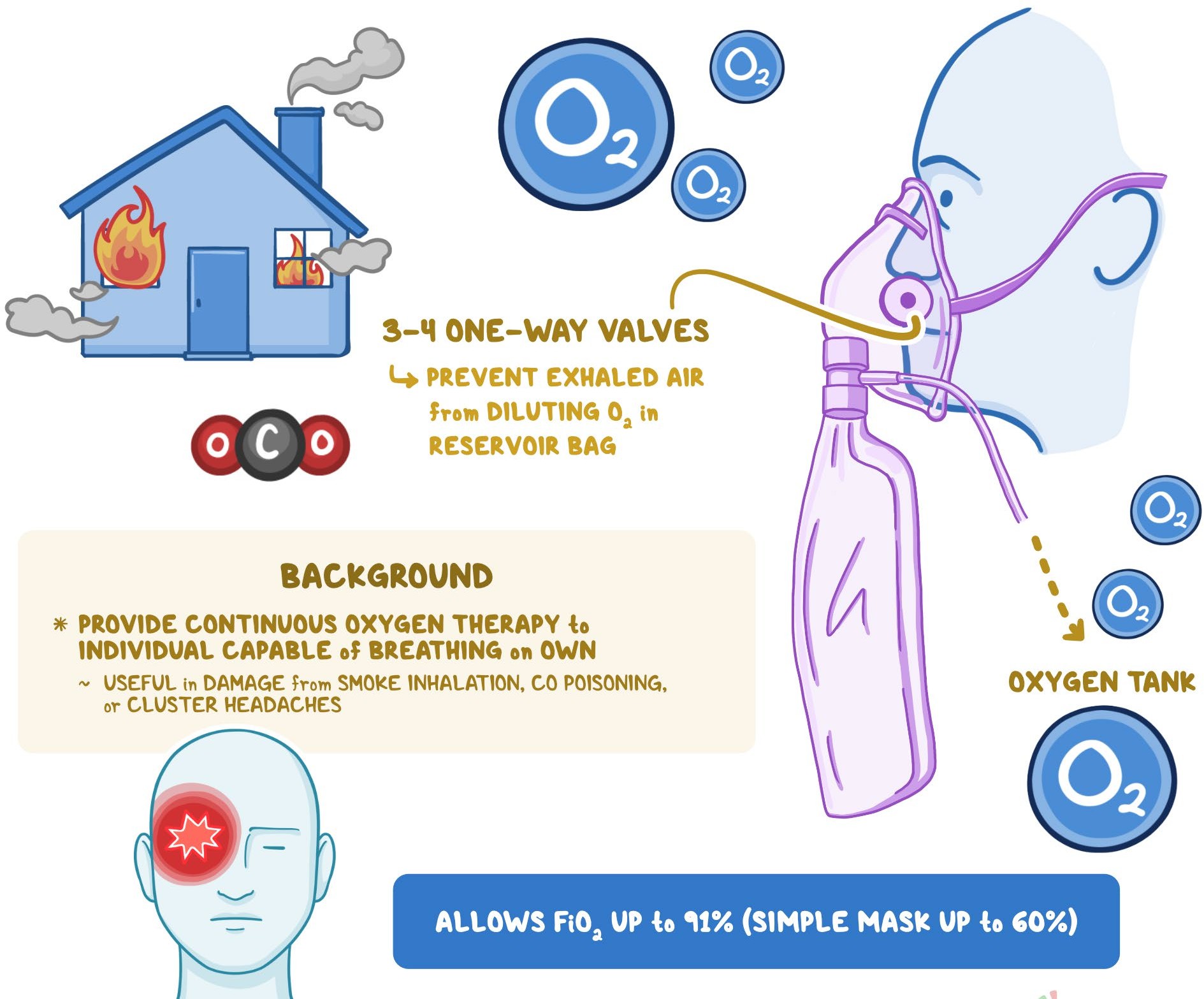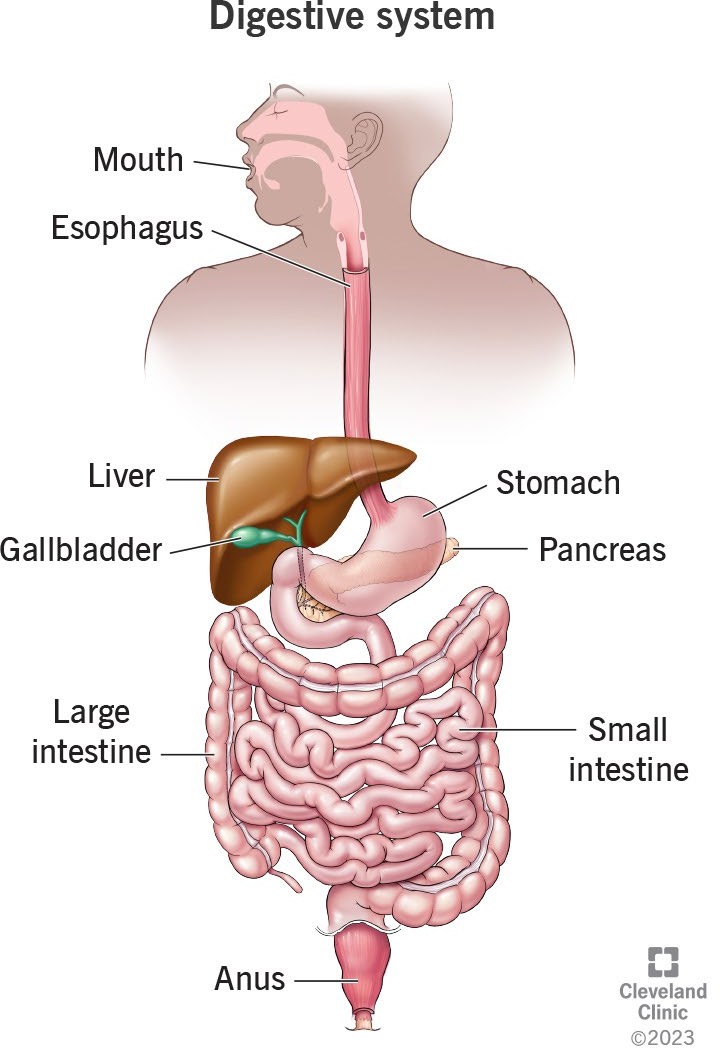NUTRITION(FINAL)
NUTRITION(FINAL)
Total Questions : 46
Showing 10 questions Sign up for moreA nurse is reinforcing teaching with a newly licensed nurse about a nonrebreather mask. Which of the following
instructions should the nurse include?
Explanation
Choice A reason: The reservoir bag on a nonrebreather mask should not collapse with exhalation. It is designed to maintain a continuous flow of oxygen and reserve a volume of oxygen for the patient to inhale with each breath.
Choice B reason: While high-flow oxygen can dry a patient's mucous membranes, a nonrebreather mask typically has a high oxygen flow rate, and humidification can be used to prevent drying.
Choice C reason: A nonrebreather mask must fit snugly over the patient's face to ensure that the highest concentration of oxygen is delivered and that there is minimal dilution with room air.
Choice D reason: A nonrebreather mask is used to deliver high-flow oxygen, not low-flow. It is designed to provide a high concentration of oxygen, typically around 60% to 90% FiO2.

A nurse is assisting with teaching a client who is on a low potassium diet. Which of the following instructions should the nurse include?
Explanation
Choice A reason: Granola may contain ingredients like nuts and dried fruits that are high in potassium, which is not
suitable for a low potassium diet.
Choice B reason: Many salt substitutes contain potassium chloride instead of sodium chloride, and using them can increase potassium intake, which is not recommended for a client on a low potassium diet.
Choice C reason: Molasses is high in potassium, so replacing sugar with molasses when baking would not be
appropriate for someone on a low potassium diet.
Choice D reason: Orange juice is high in potassium compared to apple juice, making it an unsuitable choice for
someone on a low potassium diet.
A nurse is assisting with teaching a client who is preoperative for a sigmoid colostomy. Which of the following statements should the nurse include?
Explanation
Answer: B
Rationale:
A. "You should expect your stoma to be a purple color": A healthy stoma should be pink or red in color. A purple or dark-colored stoma may indicate poor blood flow and could be a sign of complications requiring immediate medical attention.
B. "You will have a stoma in your left lower abdomen": For a sigmoid colostomy, the stoma is typically located in the left lower quadrant of the abdomen. This placement is consistent with the nature of the procedure and is a correct and important piece of information for preoperative teaching.
C. "Your colostomy will not produce formed stool": A sigmoid colostomy usually results in the production of more formed stool because it is located closer to the rectum, where most of the water has been absorbed. Expecting unformed stool is more typical of a colostomy in the ascending or transverse colon.
D. "The end of the stoma will be painful after this procedure": While some discomfort is normal postoperatively, the stoma itself should not be persistently painful. Pain management and proper care should be addressed, but ongoing severe pain could indicate complications.
A nurse is planning care for a client who reports heartburn. Which of the following tests should the nurse anticipate in the client's plan of care?
Explanation
Choice A reason: An upper GI endoscopy is typically performed to evaluate symptoms of persistent heartburn, as it allows direct visualization of the esophagus, stomach, and duodenum, which are commonly affected by conditions that cause heartburn.
Choice B reason: Flexible sigmoidoscopy is used to examine the lower part of the colon, which is not typically
associated with symptoms of heartburn.
Choice C reason: A colonoscopy is used to view the entire colon and is not the first choice for investigating heartburn,
as this symptom is not directly related to the colon.
Choice D reason: A lower GI series, or barium enema, is an X-ray examination of the large intestine, which includes the colon and rectum. It is not typically used to diagnose conditions that cause heartburn.
A nurse is providing skin care for a client who has urinary incontinence. Which of the following actions should the nurse take?
Explanation
Choice A reason: Warm water should be used to clean the skin, as hot water can cause further irritation.
Choice B reason: Friction should be avoided when drying the skin to prevent damage. The skin should be patted dry
gently.
Choice C reason: Soap can be too harsh and drying for the skin, especially if it is already compromised by incontinence. A mild, pH-balanced cleanser is recommended.
Choice D reason: A barrier cream is essential to protect the skin from moisture and irritants found in urine, which can lead to skin breakdown and incontinence-associated dermatitis.
A nurse is assisting with teaching a class about the process of digestion. The nurse should include that food is transported through the gastrointestinal (GI) tract starting from which of the following locations?
Explanation
Choice A reason: The small intestine is not the starting point of the digestive process. It is where most of the digestion and absorption of nutrients occurs after the food has been processed in the stomach.
Choice B reason: The rectum is the final section of the large intestine, where feces are stored before being expelled. It is not involved in the initial stages of digestion.
Choice C reason: The stomach is involved in the early stages of digestion, particularly in the breakdown of proteins, but it is not the starting point. Food enters the stomach after being ingested through the mouth.
Choice D reason: The mouth is the correct starting location for the digestive process. Here, ingestion takes place, and mechanical digestion begins with chewing, while chemical digestion starts with enzymes in the saliva breaking down carbohydrates.

A nurse is collecting data on a client who has urinary retention. Which of the following findings should the nurse expect?
Explanation
Choice A reason: Dark-colored urine can be a sign of dehydration or the presence of certain substances in the urine, such as blood or bile, but it is not typically associated with urinary retention.
Choice B reason: Leakage of urine, or overflow incontinence, can occur in urinary retention when the bladder is overfilled and the pressure within the bladder exceeds urethral resistance. This can lead to involuntary release of urine.
Choice C reason: Blood in the urine, or hematuria, can indicate various conditions, including infections, stones, or tumors, but it is not a common finding specifically associated with urinary retention.
Choice D reason: Cloudy urine may suggest the presence of phosphates (a normal occurrence in alkaline urine), infection, or the presence of pus (pyuria). While it could be associated with a urinary tract infection that might lead to urinary retention, cloudy urine itself is not a direct indicator of urinary retention.
A nurse is collecting data on a client who has circulatory overload. Which of the following findings should the nurse expect?
Explanation
Choice A reason: Tachycardia, or an abnormally rapid heart rate, is a common finding in circulatory overload due to
the increased volume of blood the heart must pump.
Choice B reason: Weight loss is not typically associated with circulatory overload. In fact, weight gain may occur due
to fluid retention.
Choice C reason: Diaphoresis, or excessive sweating, can be associated with circulatory overload as the body attempts to cool down due to the increased blood volume and workload on the heart.
Choice D reason: Hypotension, or low blood pressure, is not a usual finding in circulatory overload. Instead, hypertension may be more likely due to the increased volume of fluid in the blood vessels.
A nurse is collecting data on a client who has Chronic Obstructive Pulmonary Disease (COPD). Which of the following findings should the nurse expect?
A. Pleural friction rub
B. Peripheral edema
C. Spoon nails
D. Hyperresonance on percussion
Explanation
Choice A reason: A pleural friction rub is associated with conditions that cause pleural inflammation, such as pleuritis or pneumonia, rather than Chronic Obstructive Pulmonary Disease (COPD). While patients with COPD may experience other abnormal lung sounds like wheezing or crackles, pleural friction rubs are not typically a feature of COPD.
Choice B reason: Peripheral edema is a common finding in clients with advanced COPD, particularly in those who develop right-sided heart failure (also known as cor pulmonale). The prolonged hypoxia and pulmonary hypertension that often accompany COPD can put additional strain on the right side of the heart, leading to fluid retention and swelling in the extremities. This is a typical finding in later stages of COPD.
Choice C reason: Spoon nails (koilonychia) are typically associated with iron deficiency anemia or other conditions affecting the circulatory system. Although COPD is a chronic respiratory condition that can impact oxygenation, spoon nails are not commonly associated with COPD. This condition is more commonly seen in anemia or other nutritional deficiencies.
Choice D reason:
Hyperresonance on percussion is a typical finding in COPD, especially in those with emphysema, where air trapping occurs. This is due to the destruction of lung tissue and the over-inflation of alveoli, which creates a more resonant sound when the chest is percussed. This finding indicates the presence of hyperinflated lungs, a hallmark of emphysema and a common component of COPD.
A nurse is assisting with evaluating a newly licensed nurse who is draining an ileostomy bag for a client. Which of the
following actions by the newly licensed nurse indicates an understanding of the procedure?
Explanation
Choice A reason: Wearing sterile gloves is not necessary when draining an ileostomy bag as this is not a sterile procedure. Clean gloves are typically used.
Choice B reason: Washing the skin surrounding the ileostomy with hot water is not recommended as it can cause
irritation. Lukewarm water should be used, and the area should be patted dry.
Choice C reason: Cleaning the end of the ileostomy pouch before clamping is important to maintain hygiene and
prevent contamination when draining the bag.
Choice D reason: The ileostomy bag should be emptied when it is one-third to one-half full to prevent leakage and ensure comfort for the client.
You just viewed 10 questions out of the 46 questions on the NUTRITION(FINAL) Exam. Subscribe to our Premium Package to obtain access on all the questions and have unlimited access on all Exams. Subscribe Now



